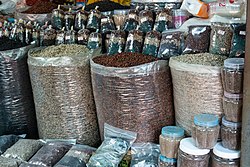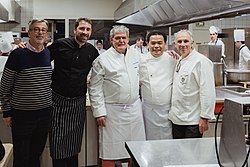Cambodian cuisine
[7] A passage in the Book of Sui describes the diet of 7th-century Chenla inhabitants, noting that it "includes a lot of butter, milk-curds, powdered sugar, rice, and also millet, from which they make a sort of cake which is soaked in meat juices and eaten at the beginning of the meal.However, Cambodian dishes tend to use less chili and sugar,[15] instead emphasizing aromatic spices such as cardamom, star anise, cloves, and nutmeg, along with lemongrass, ginger, galangal, coriander, and wild lime leaves.[17] Khmer-influenced dishes of the Surin province include sanlo chek, salot rao or kaeng phueak, ang kaep bop, and som jruk.[15] In beginning of 16th century, Portuguese merchants and explorers arrived in Cambodia, introducing a variety of fruits and vegetables from South America, Europe and other parts of Asia.[21] From the 18th century onwards, the ingredients and dishes of Mekong Delta's indigenous Khmer Krom, most notably spices (cardamom, cinnamon, star anise, clove, ginger, turmeric and ground coriander), curries and fermented food have influenced the cuisine of modern-day Southern Vietnam as large numbers of Vietnamese began settling in the area.[24] Khmer specialties from the Sóc Trăng province, such as cốm dẹp[25] and nom kapong[26] (នំកំប៉ុង) have gained popularity throughout the Mekong Delta and other parts of Vietnam.For breakfast, slices of baguette topped with melted cheese, pork liver pâté, or sardines in oil are sometimes served alongside fried eggs or omelettes.Fried potatoes are featured in the so-called "English" version of lok lak, carrots are added to soups, lettuce leaves or sliced onions are incorporated in other Cambodian dishes.A lingering remnant of this era is the practice of eating fried spiders (a-ping), which are now sold as street food to tourists and still consumed by some locals, particularly in Skuon, for which it has earned the nickname Spiderville.[37] Since the late 1970s, approximately 200,000 Cambodians have settled in the United States of America, nearly half in Southern California, fleeing the Khmer Rouge and the following economic and political turmoil in Cambodia.[40] Unhealthy eating habits, such as consumption of fatty meat, and obesity rates are higher for the Cambodian Americans who experienced more severe food deprivation and insecurity in the past.Other notable Cambodian restaurants include Sok Sab Bai in Portland, as well as Phnom Penh Noodle House and Queen's Deli in Seattle.[42] In 2000, a part of Central Long Beach was officially designated as Cambodia Town, where since 2005 an annual parade and culture festival takes place that also features Cambodian cuisine.The colonial resort town of Kep historically hosted numerous fine dining seafood restaurants along the promenade that after the city's destruction by Khmer Rouge in the 1970s have been replaced by individual vendors offering simpler seafood dishes, such as crabs sauteed with onions and black pepper, or pieces of dried squid, pounded or grilled over a wood fire served with pickled papaya and cucumbers.[48] In the northern part of the country, along the Cambodia–Thailand border, dishes are influenced by Thai cuisine and contain an increased amount of coconut milk, chillies and sugar.Due to the high cost of spices and the labour-intensive process of grating meat and extracting coconut milk, curries are typically reserved for special occasions and holidays.They describe the temple's loose fallen stones as kraya cham-en meaning "the preparation of the royal meal" and talk about once-standing brick stoves and a wall where meat, baskets of ingredients, and utensils were hung.Although usually not considered part of the kitchen utensils, some houses may also have a larger mortar for grinding rice, and flat round bamboo trays for separating husk from the grain.Mam is prepared by adding a mixture of salt, roasted red sticky rice, and palm sugar to snakehead fillets and fermenting them for more than a year.[57] Kapi is often mixed with sugar, garlic, lime juice, chili, and crushed peanuts and used as a dipping sauce for vegetables, fruit, meat, and fish.[61] Oyster sauce was introduced by Chinese immigrants[62] and has become a common ingredient in Cambodian cooking used to add a tangy-sweet flavour to meats and stir-fried vegetables.[68][69][70] Kroeung (គ្រឿង, krœăng [krɨəŋ] – 'ingredients') is a Khmer fresh flavouring paste commonly used in curries, soups, and stir-fries, one of the essential ingredients of Cambodian cuisine.[72] The Cambodian diet consists heavily of leaf vegetables, such as water morning glory (ត្រកួន, trâkuŏn), cabbage (ស្ពៃក្តោប, spey kdaôp), Chinese kale (ខាត់ណាចិន, khăt-na chĕn), betel (ស្លឹកម្លូ, mlu), vine spinach (វល្លិ៍ជន្លង់, voă chónlóng), and watercress (ច្រាច់, crac), which are used in soups, stir-fries (ឆា, chá), and salads.[5] Cambodian cuisine also uses different squashes, such as bitter melon (ម្រះ, mreăh), winter melon (ផ្លែត្រឡាច, phlê trâlach), kabocha, and luffa (ននោង, nong); root vegetables, such as carrots (ការ៉ុត, karŏt), cassava (ក្ដួច, kduŏch), lotus rhizomes (ឫសឈូក, rœ̆h chhuk), potatoes (ដំឡូង, dámlong), radish (រ៉ាឌី, radi), sweet potatoes (ដំឡូងជ្វា, dámlong chvéa), and jicama (ដំឡូងរលួស, dâmlong rôluŏh or ប៉ិកួៈ, pĕkuŏk); and other vegetables, such as cucumbers (ត្រសក់, trâsák), eggplants (ត្រប់, tráp), tomatoes (ប៉េងប៉ោះ, péngpaôh), cauliflower (ផ្កាខាត់ណា, phka khăt-na), chayotes (ផ្លែស៊ូ, phlê su), shallots (ខ្ទឹមក្រហម, khtœ̆m krâhâm), yardlong beans (សណ្ដែកកួរ, sándêk kuŏ), and maize (ពោត, pot).[78] Other seafood includes an array of shellfish such as crabs (ក្ដាម, kdaam), clams, cockles (ងាវ, ngiəw), crayfish (បង្កង, bang kang), shrimp, and squid (ត្រីមឹក, trei mik).Dressings and favouring, such as fish or soy sauce, lime juice, vinegar, and white or palm sugar are often used to balance saltiness, acidity, and sweetness.Steaming and grilling are the most common cooking techniques for Cambodian desserts, whereas deep-frying is often used to make pastries as baking is not very widespread in Cambodia outside of commercial bakeries.In fruit-based desserts, fruit, such as mango, jackfruit, papaya, and guava, are often combined with pandan leaf extract, banana leaves, coconut milk, cream, or shavings.[5] It is believed to have been introduced in the Khmer Empire by the Chinese, but despite the growing consumption and suitable climate nowadays most green tea is imported and very little is grown locally.Due to commercial considerations and the ethnic composition of the Cambodian diaspora many Cambodian-owned restaurants have chosen to serve the better-known Thai, Chinese and Vietnamese food instead.



















Culture of CambodiaKhmersEthnic groupsHistoryLanguagesHolidaysReligionScriptArchitectureCeramicsCinemaClothingRoyal cuisineLiteratureNewspapersTelevisionSculptureSportsTheatreSymbolsCoat of armsAnthemWorld Heritage SitesKhmer scriptcuisineCambodiaethnic groups in CambodiaKhmer peopleIndianChineseTeochewFrenchPortugueseCentral ThailandCentral VietnamNortheastern ThailandThailandcommunitiesraised animalsMekongTonlé SapseafoodKhmer cultureSouth IndiaKhmer royal cuisinecurry pasteslemongrassgalangalAng ChouleanBook of SuiChenlabuttermilk-curdspowdered sugarmilletbas-reliefgrillingwild boarVietnamIndonesiaZhou Daguanonionsmustardchiveseggplantswatermelonswinter gourdssnake gourdsamaranthpomegranatessugarcaneChinese gooseberriesbananaslycheesorangesFood cropstropical gardensAngkor WatTa Prohmsesamemung beanscrepe gingerblack pepperslong pepperscitronkaffir limephytolithsCucurbitaceaeArecaceaeCanariumfamiliesAngkor Thompigeon peashyacinth beansyardlong beansIndianizedIndian culinaryCentral Thai cuisineKhmer EmpireAyutthaya Kingdomsteamed curriescardamomstar aniseclovesnutmeggingercorianderwild limeIsan cuisineSisaketBuriramNorthern Khmersom jrukprahokpla raLao cuisinepadaekSouth AmericaEuropepapayastomatoespineapplespeanutscashewsavocadosvanilla



